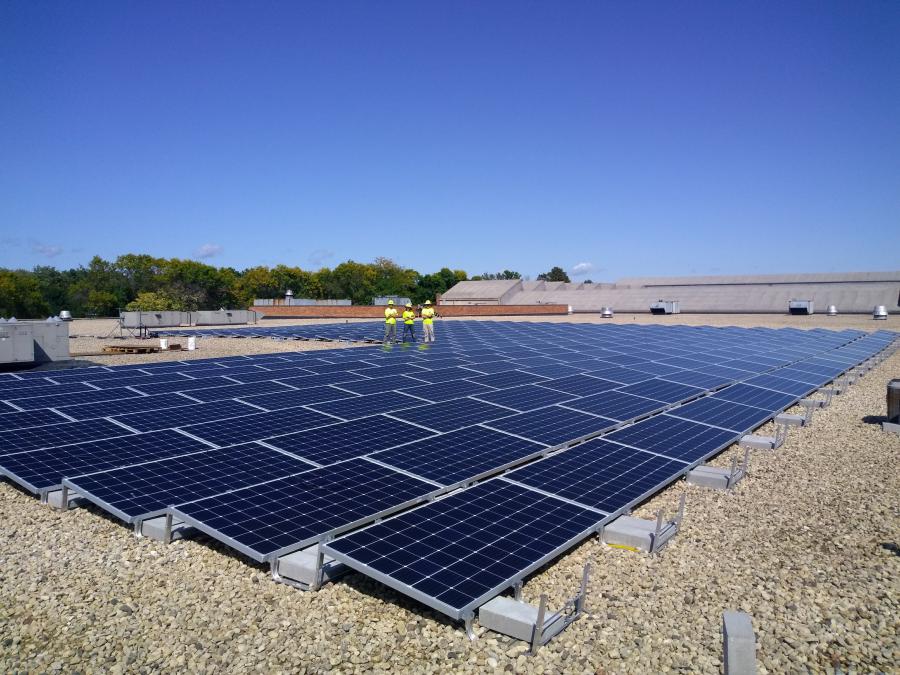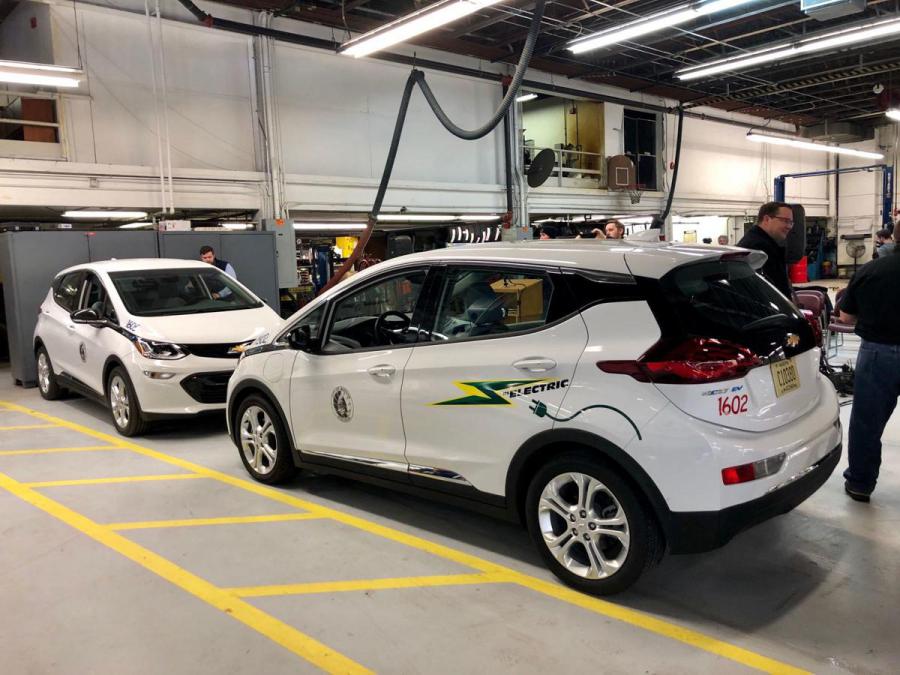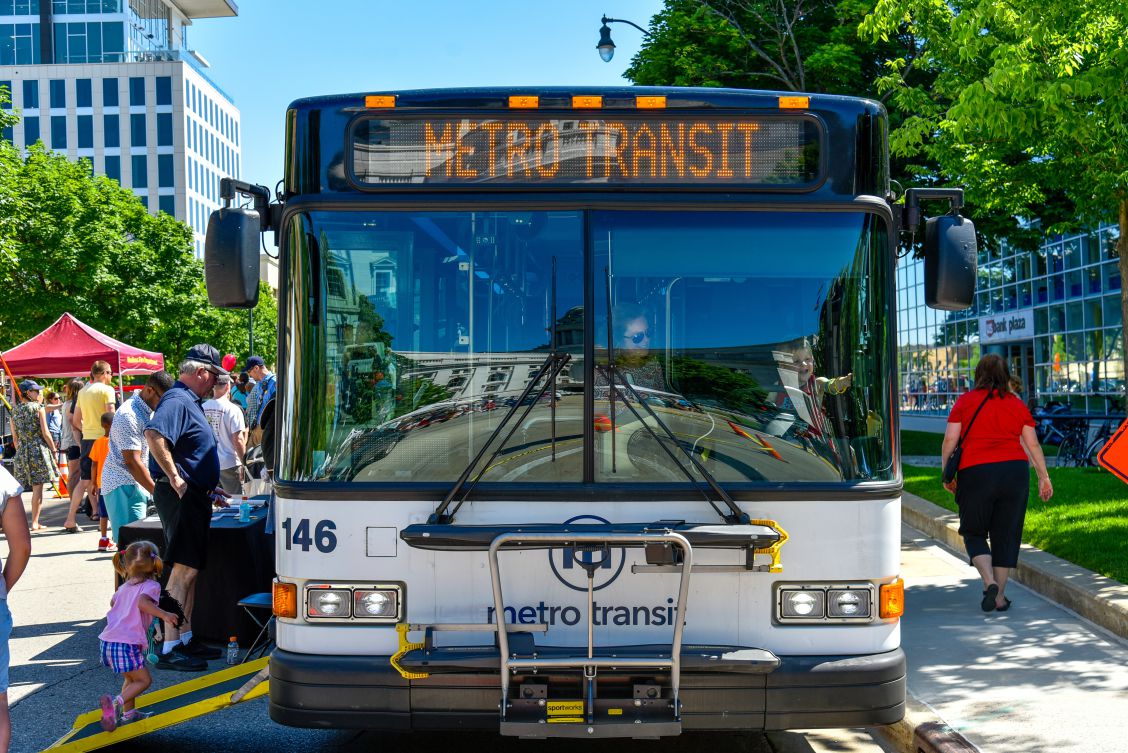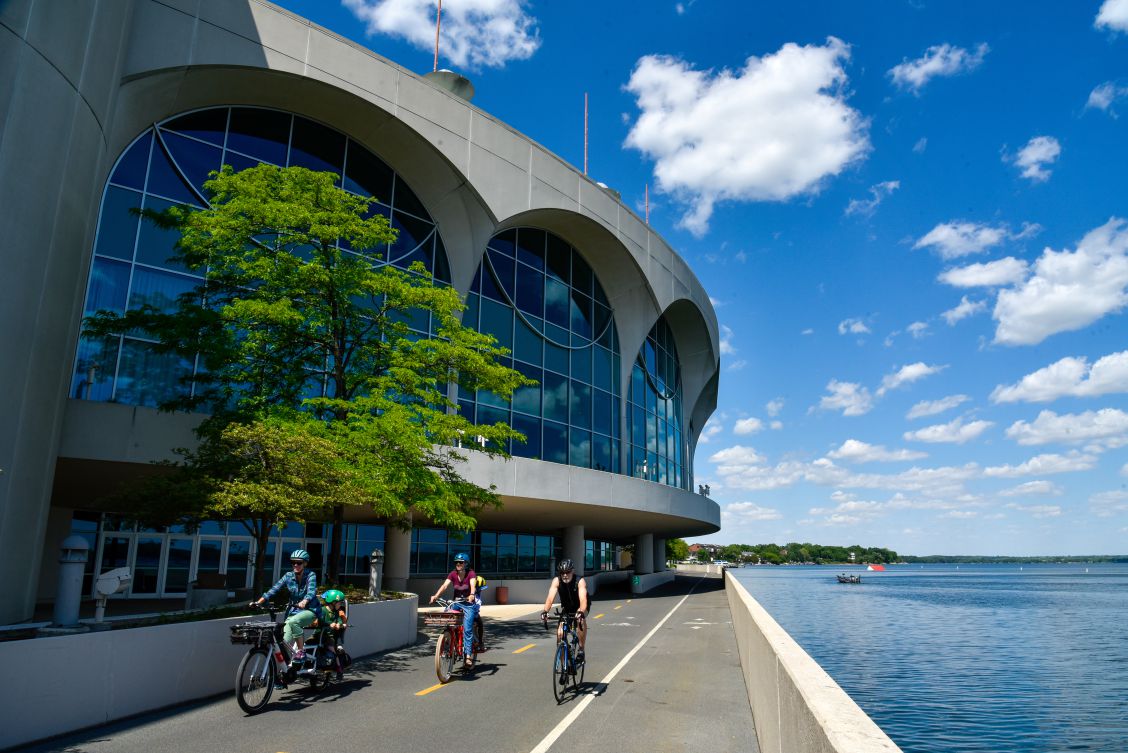Climate Action Spotlight – 15 Ways Madison is Leading on Climate
posted

Climate action is currently receiving even more attention than usual, in part due to recent passage of both the Bipartisan Infrastructure Law (BIL) and the Inflation Reduction Act (IRA) that will provide unprecedented federal support for reducing greenhouse gas emissions, advancing environmental justice and improving resilience to the impacts of climate change.
So, many folks might be wondering what the City of Madison is up to on climate. I’m happy to share that we’re taking action across the board and making big strides in reaching our goal of 100% renewable energy and net zero carbon emissions for City operations by 2030 and community-wide by 2050. Here’s a roundup of just some of our climate-focused work.
Top Madison Climate Actions:
- Using clean energy for City operations. Nearly 75% of electricity for City operations comes from renewable sources, putting us well on the way to our goal of 100% clean energy by 2030. To achieve success, we are taking an innovative and multifaceted approach that has so far included producing our own renewable energy, participating in Madison Gas and Electric’s Renewable Energy Rider program and purchasing renewable energy credits.
- Installing solar at City facilities. We have installed more than 1.3 MW of behind-the-meter solar at City facilities, and we plan to install another 8 MW by 2030.
- Providing green workforce training through our GreenPower program. The GreenPower program prepares young people for careers in clean energy and the trades. Trainees work alongside electricians from the city’s Engineering Division on solar and energy efficiency upgrades at city facilities.
- Spreading solar in the community. Our MadiSUN program, administered by local nonprofit partner RENEW Wisconsin, works to expand solar energy for homes, businesses and nonprofit organizations in the community through grants and group purchasing. So far, the program has supported development of more than 2 MW of solar in our community.

- Leading on green buildings. Since 2008, we have committed to reaching LEED Silver certification or better for all new and renovated City buildings. We now have 14 LEED certified buildings, including 5 with Platinum certification, with 6 more in progress. We were proud to receive a 2022 Energy Efficiency Excellence Award from Focus on Energy in recognition of our work to maximize energy efficiency.
- Investing in energy efficiency for naturally occurring affordable housing. We are collaborating with Sustain Dane and Elevate Energy to provide clean energy and energy efficiency upgrades to 100 units of affordable, multi-family rental housing through a new pilot program. The program will reduce energy and water use by 10-20%, which could save tenants and building owners $400 a year or more.
- Decarbonizing our Fleet. We’re transitioning our fleet to low and no-carbon fuels. So far, we have over 60 electric vehicles, more than 100 hybrid-electric vehicles, 3 all-electric buses and we use a mix of Wisconsin-made biodiesel for all trucking. And the Madison Fire Department is running North America’s first and only operational electric fire engine – the Volterra made by Wisconsin-based Pierce Manufacturing.
- Providing all-electric Bus Rapid Transit. The new BRT system will expand access to low-cost, reliable transportation using zero-emissions electric buses, making it easier for folks to from point A to point B without the expense of owning a car.
- Growing sustainable transportation options. Through Complete Green Streets and Vision Zero, we are updating and expanding our transportation network to support walking, biking and other active transportation and expanding green infrastructure and other solutions to grow resilience. In 2021, we passed an ordinance that requires EV charging for new multifamily residential and some commercial development to enable more folks to switch to an electric vehicle.
- Partnering for regional, statewide and national action. Collaboration is key to reducing carbon emissions at the pace and scale needed to avoid the worst impacts of climate change. To leverage local action for greater impact, Madison, along with Dane County, convenes the Sustainability Leaders Collaborative, a group of elected leaders and staff from Dane County municipalities that share information and lessons learned on solar installation, green fleets and more. I also use my voice representing Madison to collaborate with other cities and represent our needs at the national level as a Vice Chair of Climate Mayors and Chair of the EPA’s Local Government Advisory Committee Air and Climate Workgroup.
- Growing our climate capacity. In 2021, we hired Madison’s first Sustainability and Resilience Manager to lead our work to reduce emissions and grow resilience to the impacts of climate change.
- Reducing flood risk across Madison neighborhoods. Since the 2018 floods, we are going all in on flood resilience by updating Madison’s stormwater ordinance in 2020, embarked on detailed watershed studies, upgrading our stormwater infrastructure to better handle large rain events and investigating ways to expand our use of green infrastructure.
- Prioritizing climate and equity in City purchasing. In July, we issued the first-ever citywide RFI to help identify and do business with a diverse pool of vendors, business owners, local businesses and entrepreneurs, especially those that can assist in reducing carbon emissions for City operations.
- Converting our streetlights to LEDs. The City’s Traffic Engineering team is undergoing a multi-year effort to convert all of the City’s nearly 6,000 streetlights to efficient LED bulbs, saving us energy and money and reducing carbon emissions in the process.
- Requiring sustainability features in our affordable housing funding. The City Affordable Housing Fund helps the private sector develop long-term affordable housing in Madison. We require applicants for these funds to reduce energy use by 20% based on a Focus on Energy analysis and install at least 30 kW of solar on site.
And we have more in the works. For example, we’re working to develop the new Building Energy Savings Program to cut carbon emissions from the built environment while reducing energy costs for commercial building owners and tenants. And an updated, city-wide Transportation Demand Management program will help to further expand sustainable transportation options. We’re also exploring the use of low carbon concrete.New and expanded federal support provided through the BIL and IRA will help us accelerate and grow our current climate successes. We have a strong track record of securing state and federal funding to support our work – the City typically receives and manages $50-75 million in federal and state grant awards annually – and are prepared to make sure Madison benefits from these federal climate investments.
Don’t forget the Inflation Reduction Act provides funding directly to local households and businesses to take actions that reduces their energy costs and carbon footprints. Check out this tool by Rewiring America to calculate how much money you could get from the IRA. And visit Cleanenergy.gov to sign up for updates about when IRA tax credits and rebates become available.
Subscribe to Mayor Satya's Blog Updates
Archive
- ACRE Program Aimed at Promoting Diversity in Real Estate Industry Now Accepting Applications
- Madison is Investing in Summer Youth Programing
- Become a Crossing Guard to Help Keep Madison Safe
- Statement from Mayor Rhodes-Conway on Common Council Approval of Zoning Change for Johnson and Bassett Development
- Creative Thinking Helps Close Workforce Shortages While Improving Job Quality
- Madison Declares April Care Workers Recognition Month
- Celebrate National Library Week April 23-29
- Earth Day Celebrations in Madison
- Technology, Education and Construction Work Together to Keep Our Roads Safe
- Celebrating National Community Development Week
- Library Writing Contest Lifts Up Youth Voices
- The Importance of Volunteers in Madison Parks
- Investing in South Madison
- Mayor’s Remarks at 2023 MadiSUN Kickoff Event at Mt. Zion Church
- Open House for Upcoming Plans in Northeast Area
- How Madison Can Help with Your Spring-Cleaning
- Mayor’s Remarks from Today’s Press Conference Regarding Planned Salvation Army Shelter
- Dane CORE 2.0 Rental Assistance Program Applications to End May 31
- A Look Back on 2 Years of ARPA’s Impact on Madison
- City Honors Tibet Day with Flag Raising and Mayoral Proclamation
- Madison Declares Today International Women’s Day
- Join Us for "In Her Boots" Documentary to See the Story of 40+ Years of Women in the Madison Fire Department
- The MOST Support for Our Young People
- December 2022 #TeamCity Awards
- Streatery Program Celebrates a Successful 2022!
- Mayor’s Remarks at Historic Bus Rapid Transit Groundbreaking
- Complete Green Streets Initiative Moving Forward
- Mayor’s Remarks at December Public Safety Briefing
- Celebrate Love with Music this Perfect Harmony Chorus Day
- The CDA’s Early Designs for Redeveloping the Triangle are Taking Shape
- Mayor and Alders Propose to Allow More Development Near High Capacity Transit
- Join the City in Supporting Small Businesses By Shopping Local This Holiday Season
- Madison CARES, City’s Mobile Emergency Service for Behavior Health Calls, Releases End-of-Year Report
- Mayor Satya Rhodes-Conway Issues Proclamation Declaring November 2022 Homeless Awareness Month in Madison
- As We Honor Traffic Accident Victims, Let’s Commit to Making our Streets Safer
- Madison Receives EPA Funding to Improve Air Quality Monitoring and Tackle Health Disparities
- New Sustainability and Resilience Website is Live
- Support for Community Facilities Now Available
- Don't Miss Your Opportunity: Get Signed Up for Health Insurance During Open Enrollment
- City Honors Outstanding Youth Workers for 2022 Lights On Afterschool Day
- Long-Time Employees Honored at October #TeamCity Ceremony
- City and MGE Continue Partnership to Achieve Climate and Energy Goals
- Let’s Get to 10,000 Pounds Composted by October 25!
- Dane County Climate Champions
- City of Madison Transforms Absentee Ballot Boxes
- Celebrating Summer’s Successes
- Climate Action Spotlight – 15 Ways Madison is Leading on Climate
- Madison’s Celebration of African Immigrant Heritage
- City Thanks MG&E Foundation
- Seniors in Madison Empowered to Age Well During National Senior Center Month
- Parks Alive – Building Strong Neighborhoods
- The Inflation Reduction Act Is a Win for Climate and our Community
- Prioritizing Affordable Housing, Climate Resiliency, and Strong Neighborhoods in My 2023 Executive Capital Budget
- MadLit is Back this Summer
- We’re Working to Make Madison Safer this Summer
- Mayor Satya Rhodes-Conway’s Statement on the Overturning of Roe vs. Wade
- Opposing the Overturning of Roe v. Wade and Establishing City Policy with Regard to the Potential Criminalization of Abortion
- Welcoming Our Afghan Neighbors on World Refugee Day
- Madison Raises Juneteenth Independence Day Flag
- Madison Flies Progress Flag for Pride Month
- Summer Violence Prevention Strategies Focus on Youth Engagement
- New Large Item Collection System a Resounding Success
- 2022 Make Music Madison
- Team City Awardees Exemplify City Values
- Public Health Announces $1 Million in Funding for Anti-Violence Work
- Community Engagement Results in Amendments to Transit Network Redesign Draft Plan
- Declaring May 11 Rebecca Blank Day in the City of Madison
- Earth Month’s a Wrap!
- Enjoy the Madison Arts Scene with Gallery Night
- Plan, Use, Create, Scrap: A New Approach to Food Waste
- Madison’s Pollinator Pledge Reaffirmed
- Congratulations to the 2022 Neighborhood Grant Recipients!
- Unanimous Approval of Site for Men’s Homeless Shelter
- Continued Collaborative Efforts for Safe Roads
- MadiSUN Launch Event
- Ukraine Solidarity Proclamation
- Vision Zero Action Plan Overview
- City of Madison Green Power Program Featured by US DOE
- Celebrating Earth Day All Month in the City of Madison
- Sharing Your Ballot Drop Box Stories as the Wisconsin Supreme Court Weighs the Future of Drop Boxes
- City CARES Team for Mental Health Emergencies Now Answering Calls City-Wide
- Make a Plan to Vote for the April 5 Spring Election
- Madison Lends a Helping Hand to Our Undocumented Immigrant Population
- The City of Madison is Celebrating Women’s History Month
- Financial Assistance to Homeowners Impacted by the Coronavirus Pandemic Now Available via Wisconsin Help for Homeowners Program
- Artists at Work
- Give us your Feedback on the Transit Network Draft Plan
- March #TeamCity Awards Celebrate Individuals and Teams Who Go Above and Beyond
- Permanent Streatery Program Proposed
- Become an AASPIRE Intern with the City Today
- Madison Supports State Standards for PFAS
- Supporting Amtrak’s Right-of-Way to Bring Passenger Rail to Madison
- Olbrich Gardens-Thanking our Volunteers
- Madison Supports State Standards for PFAS
- Voting Rights Under Attack – Share Your Ballot Drop Box Stories
- Nationwide Safe Streets Approach Supports Madison’s Vision Zero
- ARPA Allocations Connect Vulnerable Madisonians to Basic Needs
- How to Get the Most Out of Tax Season
- Funds Are Still Available for WEDC Main Street Bounceback Grant
- Madison’s Language Access Plan and Bilingual Pay Differential
- Madison Stands in Solidarity with the Jewish Community
- Madison Common Council Recognizes February 2022 as Black History Month
- Black History Month at Madison Libraries
- Gun Bills in Legislature Make Problem Worse Not Better
- Winter Fun in Madison Parks 2022
- The City Continues to Prioritize Traffic Safety
- You are Invited to the 37th Annual Observance of Dr. Martin Luther King, Jr. Monday
- Façade Grants Beautify Downtown & Neighborhood Businesses
- Team City Awards Recognize Outstanding Employees
- Supporting a Diverse, Local Business Community
- Update on City Progress Addressing Unsheltered Homelessness
- Madison’s 2022 Budget Funds Three New Multilingual Community Connectors
- Madison Proclaims November 25 - December 10, 2021 as “16 Days of Activism to End Gender-Based Violence
- City Moves Forward on Help for Unsheltered
- Office of City Attorney Sends Letter to Special Counsel
- City of Madison Celebrates Exciting Groundbreaking Season in Affordable Housing
- Operation Fresh Start is Saving Landscapes and Changing Lives of Madison Youth
- Olbrich Gardens-A Crown Jewel of the City-Now Even Better
- Fleet Gathering 2.0 Showcases Sustainable Efforts
- Today is Indigenous Peoples Day in Madison
- September #TeamCity Awards Celebrate 5 Outstanding City Staff Members
- Mayor Satya: Proper Place for Gableman Interviews is in Front of Capitol Committee
- Mayor Rhodes-Conway Releases 2022 Executive Operating Budget
- Traffic Safety Efforts Continue on East Washington Avenue
- Voter Registration Drives at 19 City Locations on National Voter Registration Day, Tuesday, Sept. 28
- Tell Us What You Think of Metro’s Service Map Options!
- Recognizing September 15, 2021, through October 15, 2021, as Hispanic Heritage Month
- Update on City Plans for the Unsheltered
- Redistricting & You
- 24th Annual Madison Bike Week celebrates biking for transportation, leisure, and fitness
- Madison’s Multifaceted Response to Gun Violence
- Public Information Meeting for Town of Madison Residents
- Safer Streets Start with You
- City Working to Prevent Evictions and Ensure Household Stability
- Announcing My 2022 Executive Capital Budget and Capital Improvement Plan
- Madison CARES
- Madison Out-of-School Time (MOST) recognizes eleven Outstanding Youth Workers for their dedication and creativity supporting youth during the pandemic
- Age Friendly Communities
- ARPA Allocations Keep Valuable Youth Employment Programs Alive
- Sina Davis Movies in the Park - Entertainment and Community
- Madison Joins the Cities Race to Zero
- 2021 Assembly Bill 414: Legislation attacking anti-racism and anti-sexism training for government employees
- Celebrating Olbrich’s Volunteer Crew
- No Shortage of City Employees to Honor - Meet our Newest #TeamCity Award Winners
- Help Available to Renters as Federal Eviction Moratorium Ends
- Disability Pride Month: Making Madison Accessible via Transit
- First ARPA Funds Bridge Gap for Many of Madison’s Marginalized Communities
- Honoring Carmella Harris with the Reverend Wright Human Rights Award
- Watch: Council Briefing on Bus Rapid Transit or “Metro Rapid”
- More Mad Lit Dancing and Fun in the Works
- Not a single traffic death is acceptable
- The Bubbler Gives Madison Youth a Voice through Art
- Bus Rapid Transit an Opportunity for Revitalization
- Legislature’s Budget Bill Undermines State’s COVID Recovery
- The Wisconsin Legislature’s Attack on Your Body
- City of Madison Receives $10,000 from Healthy Babies Grant Initiative to Improve Children’s Health and Reduce Disparities
- Celebrating Madison Fleet Services New Home
- Mayor Proposes Millions in Federal Funds to Support Housing, Shelter, Businesses, Youth, and Violence Prevention
- The Train is Back on the Table
- Madison Commemorates and Celebrates Juneteenth
- City of Madison CARES: Public Information Session for Alternative Crisis Response Team Scheduled for 7 p.m. on Tuesday, June 22
- Madison Fire Leads the Way
- Madison Guaranteed Income Advisory Task Force Convenes Kick-off Meeting
- Third Team City Award Ceremony of 2021 Recognizes Five
- Madison Common Council Condemns Anti-Trans Bills in State Legislature
- Building an Equitable Music Ecosystem
- City and MMSD Partner to Provide Free Summer Bus Passes to All Middle and High School Students for the First Time
- Four Legged Partners Helping with Invasive Species
- Madison’s Libraries Now Open
- Madison Declares Saturday Harvey Milk Day
- City’s MadiSUN Program Showcases Solar Installation at Linden Cohousing
- Looking Back On Our Pandemic Response
- Mayor Announces Madison Pop-Up Shop Initiative
- State Legislature Targeting Madison's Snazzy Vote Drop Boxes
- Slower Speeds Save Lives and 20 is Plenty
- Helping Homeless Families in Madison
- Madison Guaranteed Income Pilot Raises More than $300,000 from Local Donors
- Shape the Future of Metro Service! Take Our Survey Today
- Announcing Climate Forward
- How Madison Made an Impact on Failing Food Systems During COVID-19
- Many Resources Available for Residents Seeking Financial Assistance Due to COVID-19 Hardship
- Mayor’s “Housing Forward” Sets Vision for Madison
- Midwest Mayors Write Secretary Buttigieg to Urge Expansion of Amtrak’s Hiawatha Line
- Celebrate National Library Week
- Celebrating National Community Development Week
- A (Pandemic) Year in the Life of Olbrich Gardens
- Get Green with the City this Spring
- #TeamCity Awards
- The American Rescue Plan Act is an economic lifeline and a bridge to our future
- Be Informed: Check Out Advisory Referendum Questions on the April 6 Ballot
- Governor Evers Proposes Long-Needed Action on Climate Change
- A Big Step Forward for Madison's Homeless Services
- Metro Should Deliver Front Door Transit Service
- Celebrating International Women's Day
- Progress Underway on Creation of Alternative Emergency Responders
- March 1: A Day of Remembrance and Recovery
- Supporting the Federal Equality Act
- Health Insurance Resources Available to Madisonians
- Supporting Small Business
- Emergency Rental Assistance: Local and Federal
- New Administration Takes Action on Immigration
- Black History Month Resources & Events from Madison Public Library
- Black History Month
- Madison Applauds President Biden’s Announcement that All Federal Fleets Will Be 100% Electric
- Supporting Our Unsheltered Neighbors
- Recognizing February 2021 as Black History Month in the City of Madison.
- Honoring Madison’s Health Care Heroes Battling COVID-19
- Reckoning with the Past, Writing the Future – Thoughts on Black History Month
- Mayoral Proclamation for Madison Native Karlin Younger
- Madison Featured as a Climate-Change Haven
- Madison Joins National Gun Violence Survivors Week Movement and Pledge
- Fifty Years and Counting
- Madison Kicks off 2021 with #Teamcity Awards Focused on Teamwork
- An Open Letter to Our New President and Vice President
- Rev. Dr. Martin Luther King Jr Day Message from Mayor Rhodes-Conway
- Ya Estan Disponibles Los Fondos Para La Siguiente Ronda Del Programa De Proteccion De Pago (PPP)
- Next Round of Paycheck Protection Program (PPP) Funding Available
- Growing our Housing Options in Madison with Cooperatives
- Honoring Rev. Dr. Martin Luther King Jr.
- City Buildings and Fleet Named Dane County Climate Champions
- Madison Parks Keep You Active Outdoors this Winter
- A Message from the Streets Division-This Winter will be Different
- City Program to Support Small Businesses Underway
- Team City Awards
- Supporting Local Business and Each Other
- Safer to Report Harassment Under our New Policy
- Madison to Receive up to $500,000 to Support Guaranteed Income Pilot
- Madison Receives Highest Possible Score in Human Rights Campaign Annual Report
- Centering Racial Equity and Social Justice
- Displacement of Elderly Residents
- An Open Letter In Support of Meaningful Conversation and Action to Address Systemic Racism in Government and all American Institutions
- Eight Can’t Wait
- Addressing Racial Bias Within City Government
- Building an Inclusive Workplace
- Budget Spotlight: Housing and Community Services
- Madison ACRE Participants
- Shared Streets, Let’s Plan for Next Year
- The Federal Government Must Mitigate the Impacts of any F-35 Deployment
- Millions Available to Support Community-Based Organizations That Provide Affordable Housing
- Budget Spotlight: Equitable Economic Development Programs
- Federal Support for Alternative Crisis Response Teams
- Mayoral Proclamation: Election Hero Day
- Madison Clerk’s Office Honored for Safe, Secure Elections in the Midst of a Pandemic
- Madison Wins Salute To Local Government Awards -Effective Response to COVID-19 Challenge
- Five Mayors, One Challenge
- Asking Everyone to Do Their Part
- New Leaf & Yard Waste Pickup Schedule
- Vote Early Day is Saturday, October 24th
- In-Person Absentee Voting Underway
- Obama Highlights Madison Civilian Oversight Board
- The City's Financial Resources Hotline has been Launched
- Tough Choices on the Budget
- Millions of Dollars to Support Affordable Housing in Madison
- 2021 Executive Operating Budget Message
- Reimagining Public Safety - Progress and Budget Priorities
- Cast your ballot today!
- Pandemic Assistance for our Immigrant Residents-with clarifying information
- Local Municipalities Need Federal Pandemic Relief
- Seeking Support for Equitable Community Access to Elections
- Request to Public Service Commission to Extend Utility Shut-Off Moratorium
- The Need for Federal Pandemic Relief
- City's Streatery Program Growing Fast
- Mask Up Madison
- Mayor Rhodes-Conway and City Leaders Announce Agreement to End School Resource Officer Contract
- Juneteenth-A Message from Mayor Rhodes-Conway
- Dream Up and Dream Big-Dream Up Programs Advance
- Statement of Mayor Satya Rhodes-Conway
- Mayor Satya Rhodes-Conway and Common Council Members Write to Sheriff Mahoney
- Now Is Time For Change
- Join me in Supporting President Obama’s Call to Action on Police Reform
- Madison Mayor Tells Trump Not to Deploy the Military Against Protestors - Supports Rep. Pocan’s Bill to Require Congressional Authorization
- Statement of Mayor Rhodes-Conway Commemorating Breonna Taylor
- Statement of Mayor Rhodes-Conway
- Pride Survives
- "Streatery" Restaurant Recovery Program- A Message from Mayor Rhodes-Conway
- Phase One Reopening Begins Today in Madison
- Wear your Cloth Facial Coverings this Memorial Day Weekend!
- A Message from the Mayor About the Heroes Act in Congress
- City of Madison Invests in the Madison Black Chamber of Commerce and the Latino Chamber of Commerce to Help Businesses During the COVID-19 Crisis
- Public Health Madison and Dane County Announces Preparation Phase to Open Up Businesses in Dane County
- Data and Science Will Guide Our Decision Making
- Meet Justin Stuehrenberg- Metro Transit’s New General Manager
- Community Testing Site Now Available at Alliant Energy Center
- Your 2020 Census form – An Easy and Safe Way to Help our Community
- Friday Good News Updates
- An Update on our Community and COVID-19.
- Homegrown Harvests During the Badger Bounce Back
- Contact Tracing’s Role in Re-Opening Wisconsin
- A Friday Update of Some Good News and Opportunities from Mayor Rhodes-Conway
- COVID-19 Testing: Why It Matters to Re-Opening the Economy, What it Takes, and Where Things Stand
- How Dangerous Is This Virus? How COVID-19 Attacks the Body
- Learning from the Past
- A Message from Mayor Rhodes-Conway Regarding Mental Health Care and COVID-19
- Some Opportunities During this Pandemic
- COVID-19 Update from Mayor Rhodes-Conway
- Earth Day in the Time of COVID-19
- Badger Bounce Back - a Path to a Safer Recovery
- Mayor Rhodes-Conway's Statement in Support of First Responders during the COVID-19 Pandemic
- Some good news from Mayor Rhodes-Conway
- COVID-19 Update from Mayor Rhodes-Conway
- COVID-19 and Some Essential City Services
- Homeless Services – Response to COVID-19 Pandemic-A Message from Mayor Rhodes-Conway
- Mayor Rhodes-Conway's Statement Regarding Community Gardens and COVID-19
- City of Madison Looking for COVID-19 Cloth Face Covering Donations
- Let’s Double Down on Physical Distancing and Social Solidarity
- Thank you for Supporting Our Elections! A Message from Mayor Rhodes- Conway
- Mayor Rhodes-Conway Update on COVID-19
- Tus Tswv Zos Rhodes-Conway Daim Ntawv Qhia Txog Tsis Txhob Xaiv Ntsej Xaiv Muag Hauv Lus Zej Zog
- Reaching Out and Helping Others
- Mayor Rhodes-Conway’s Statement on Rejecting Racism in Our Community
- Mayor Rhodes-Conway’s Statement on Transportation in Regards to COVID-19
- Wisconsin is the Only State in the Nation Moving Forward with an Election at this Stage of the Pandemic
- COVID-19 Update from Mayor Satya
- Complete the Census and Encourage Others to Join You!
- Mayor Rhodes-Conway's Statement Regarding COVID-19 and Protecting the Homeless
- Mayor Rhodes-Conway’s Statement on How to Slow the Spread of COVID-19
- City of Madison Actions on Coronavirus: Updated March 24
- Mayor Rhodes-Conway's Message Today at the Press Conference with the County Executive and Public Health Director
- Mayor Satya Rhodes-Conway’s Statement on Food with Regards to COVID-19
- Statement of Mayor Satya Rhodes-Conway on Voting with Regard to COVID-19
- Mayor Satya Rhodes-Conway’s Statement on Local Business with Regards to COVID-19
- Taking Care of Children
- Mayor Rhodes-Conway Statement on City of Madison Actions on Coronavirus
- Our best defense is our collective action
Categories
- All Posts »
- Affordable Housing (37)
- Equity (120)
- Sustainability (60)
- Transit (38)
Tags
- #TeamCity
- 2021 Operating Budget
- 2024 City Budget
- 8 Can't Wait
- AASPIRE
- absentee voting
- ACRE Program
- Addressing Racial Bias
- ADUs
- Affordable Housing
- African Immigrant Heritage Month
- Air Quality
- Apprenticeship
- APRA
- ARPA
- Assisted living
- ballot drop box
- ballot drop boxes
- Bayview Foundation
- Bike Week
- Black History Month
- BRT
- Business
- CAHOOTS
- Cameron Anglophone Crisis
- Caregiver
- CARES
- CBS Sunday Morning
- Census
- Child Care
- Children
- City Fleet
- City services
- Civilian Oversight Board
- Clean Water
- Climate Champions
- Climate Change
- Climate Forward
- collaboration
- Community
- Community Development Authority
- Community Development Week
- community investment
- Community Services
- contact tracing
- CORE
- Coronavirus
- COVID
- COVID-19
- COVID-19 Relief
- Crisis Response Team
- Del Programa De Proteccion De Pago
- Department of Civil Rights
- Disability Pride Festival
- Dream Up Program
- drinking water
- Early Voting Day
- Earth Day
- Earth Day Challenge
- earth month
- Education
- Efficency
- Election Hero Day
- elections
- Electric firetruck
- Electric Vehicles
- Employment and Training
- energy
- Energy
- engineering
- Entertainment
- Entertainment & Enrichment
- environment
- Equity
- Equity Coordinator
- F-35
- F35 Noise Mitigation
- fair elections
- Federal Equity Act (H.R. 5)
- federal relief
- Financial Resources Hotline
- Fleet
- Fleet sustainability
- food
- Forward Dane
- Gambia
- gardening
- gardens
- Governor's Action on Climate Change
- Green Fleet
- green power
- Green Technology
- gun violence
- Gun Violence Survivors Week
- Health
- health care heroes
- Health Insurance Resources
- Health/Wellness
- Hiring
- Hispanic Heritage Month
- homeless
- homelessness
- Honorary #TeamCity
- Honoring Rev. Dr. Martin Luther King Jr.
- housing
- Housing
- Housing Co-ops
- housing for unsheltered
- Housing Forward
- immigration
- Inclusive workplace
- Inflation Reduction Act
- Infrastructure
- Internship
- Internships
- Jobs
- Juneteenth
- Kanifing
- leaf collection
- Length of Service
- Library
- Look Forward
- Madison Bikes
- Madison CARES van
- Madison Metro
- Madison Parks
- Madison Police
- Madison Police Department
- Madison Public Library
- Madison Water Utility
- MadiSUN
- Make Music Madison
- masks
- Mayors for Guaranteed Income
- Mayors Voting Challenge
- Mental Health
- Metro
- Metro Bus Service
- Metro Redesign
- Metro Transit
- Metro Transit Network Redesign
- Metro Transit Redesign
- MetroForward
- MFD History
- MOST
- Muncipal Equality Index
- National Library Week
- neighborhoods
- New Metro Routes
- Olbrich Botanical Gardens Frautchi Family Learning Center
- Olbrich Gardens
- Olbrich Gardens Volunteers
- Pandemic Assistance
- Paramedics
- parks
- Parks Alive
- Parks Alive!
- Paycheck Protection Program
- Perfect Harmony Chorus
- PFAS
- Policing
- polling locations
- President Biden
- Pride Month
- Prohibited Harassment and Discrimination Policy
- Public Health
- Public Safety
- public safety
- Public Service Commission
- rail
- Recycling
- Reimagining Public Safety
- Rental assistance
- Safer at Home
- Safety
- SBER
- Senior Center Month
- Shared streets
- Sister cities
- Small Business Equity and Recovery
- Small Business Equity and Recovery Grants
- Small Business Equity and Recovery Program
- social distance
- Solar
- Spring Clean Up
- Statewide Award for Janel Heinrich
- Streatery
- Streets
- Summer
- Support Local First
- Sustain Dane
- Sustainability
- Sustainable Future
- Sustainable Transportation
- Systemic Racism
- Taxes
- Team City Award Winners
- TeamCity
- Testing
- TOD
- traffic
- train
- Transit Network Redesign
- transit oriented development
- transportation
- Truax
- UW Madison
- Vice President Harris
- Vision Zero
- vision zero
- Volunteer
- Vote
- Voter Registration Day
- Voter suppression
- voting
- Wanda Fullmore Youth Internship Program
- Winter
- Winter snow removal
- Winter Season
- Women's History Month
- Youth
- Youth Empowerment
- zoning


